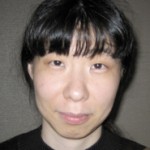
I have known Miaki Ishii for a long time—half her life—beginning with her undergraduate degree in physics at the University of Toronto. The academic world is marked by a certain transience—you meet incredible young adults of great promise, spend time teaching and mentoring them, and then they disappear into the world. I count myself extremely lucky that one such student—a young woman of singular talent and originality—decided to stay in the academic world of Earth science. So I now have the opportunity to watch her grow, see her make astonishing scientific discoveries, and, on occasion, participate in honoring her achievements, in this case, Miaki’s exceptionally well deserved Macelwane Medal.
Miaki is responsible for at least three transformative results in seismology and geophysics, each of which would have been sufficient to have her considered for the Macelwane Medal. These accomplishments reflect a rare talent for the theoretical and technical aspects of her field and an audacious scientific mind.
As a graduate student at Harvard, her supervisor Jeroen Tromp suggested several possible projects, and Miaki chose the riskiest. Specifically, she began working to estimate lateral density variations in the Earth’s mantle using seismic normal mode data. In a highly cited paper, she concluded that the lowermost mantle is characterized by denser than average material beneath the Pacific Ocean and Africa, thereby providing strong evidence for compositional heterogeneity in that region. Her work continues to be the framework for an energetic discussion at the interface between seismology, geodynamics, and geochemistry. And her perseverance showed that a quiet demeanor belies a very determined spirit.
Miaki next turned her attention to seismic anisotropy of the inner core. She combined normal modes and body waves to isolate a region at the center of the Earth that shows an anisotropy orientation that is distinct from the overlying inner core. The work, with Adam Dziewoński, is in some sense the discovery of a new region of the Earth—the “innermost inner core”—and it provides a fundamental boundary condition on inner core formation and dynamics.
As a postdoc at Scripps Institution of Oceanography, Miaki broadened her experiences, and behind her continued scientific output lies the toil of a committed seismologist. She worked tirelessly to collect Hi-Net data from Japan, leading to a seminal study with Peter Shearer, Heidi Houston, and John Vidale in which the data were back-projected to map the 1200-km-long rupture associated with the Sumatran event of Boxing Day 2004. Miaki’s remarkable analysis showed that this giant event, which led to the tragic tsunami, lasted 480 seconds and was characterized by a steady rupture velocity of 2.5 kilometers per second.
Miaki has worked on many other topics, but my point about breadth is made. Her accomplishments reveal the vision of a brilliant scientist working at the forefront of her discipline. What they perhaps do not reveal is a personality that is humble and self-effacing, a sense of humor that is playful, and a basic human decency that sometimes blunts even my attempts to poke fun at her.
Small things deflect our trajectory in life, and it is possible Miaki could have jumped, as a graduate student, into the world of quantum optics. We would have heard about her nonetheless. All the same, it’s nice that I haven’t had to lament the disappearance of that one fine young undergraduate student—instead, I can, from a very short distance, celebrate her James B. Macelwane Medal from AGU.
—JERRY X. MITROVICA, Harvard University, Cambridge, Mass.

Near‐surface structure is crucial to assessing seismic hazards and understanding earthquakes and surface processes yet is a major challenge t...


